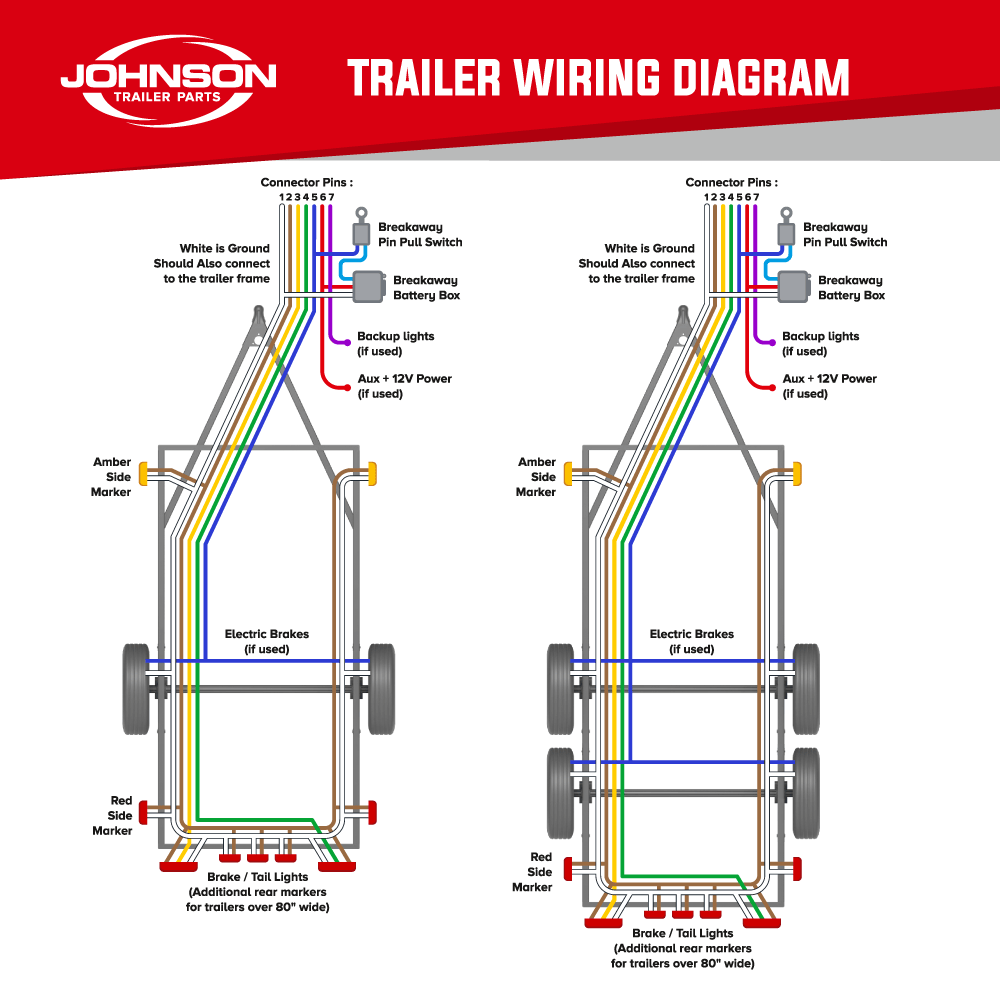Trailer Wiring Diagrams 1
Guide to Trailer Wiring: From 4 Way Flat to 7 Way Trailer Connectors
Understanding the wiring system for trailers is crucial for ensuring the safety and functionality of your towing setup. Below, we provide detailed diagrams and instructions covering the range from the simplest 4 way flat connectors to the more complex 7 way trailer connectors. These guides are designed to facilitate the wiring process, whether you’re installing new equipment or troubleshooting existing setups.
The Ground Wire
A critical aspect to remember during any trailer wiring project is the identification and correct use of the ground wire. Universally designated by a white wire, this is a fundamental component in preventing electrical issues. It’s noteworthy that many LED lights, which are becoming increasingly popular for trailers, come with black and white wires. This configuration can lead to confusion, with some mistaking the black wire for the ground. However, a solid understanding and correct identification of the white wire as the ground are essential. Most electrical problems in trailers trace back to faulty or improperly secured ground wires.
Explore the Diagrams
We invite you to examine the charts and diagrams we’ve provided below closely. They are designed to guide you through the process of wiring your trailer correctly. Whether you are working on a new project or troubleshooting, these resources are invaluable for ensuring a safe and reliable connection.
4 Way Flat Connector
Every trailer, at the very least, requires four essential functions: tail lights, brake lights, and turn signals for both left and right. A simple 4-wire setup suffices to cover these basics, making the 4 way flat connector an ideal choice for minimalistic wiring.
The 4 Way Flat Connector stands out as the most prevalent choice among the 4-wire options. This connector is typically found on lightweight trailers that do not need to accommodate brakes or additional powered accessories. It’s the go-to connector for consumer-level trailers, including small utility trailers, light boat trailers, compact campers, off-road trailers, and more, thanks to its widespread application in various types of lightweight towing solutions.
For Light-Duty Trailers Without Brakes: The 4 Way Flat Connector is Most Common
Wiring Configuration:
- White = Ground – Essential for all trailer electrical functions.
- Brown = Tail Lights, Side Markers, and Running Lights – Keeps your trailer visible and compliant with safety regulations.
- Yellow = Left Turn Signal & Brake Light – Ensures clear signaling for left turns and braking.
- Green = Right Turn Signal & Brake Light – Ensures clear signaling for right turns and braking.

For further details, please consult the Trailer Wiring Diagram and Connector Application Chart provided below. Note that with the 4 way flat connector, you only need to focus on the first four listed functions. The additional functions mentioned in the chart are not applicable for this basic connector setup.
7 Way Trailer Connector
For trailers requiring more complex electrical setups, we advise using 7-pin connectors. These connectors include two additional pins for Auxiliary Power and Back-up Lights, enhancing functionality.
If your trailer is equipped with brakes, auxiliary power, and back-up lights, a 7-pin connector is necessary. While 6-pin connectors are an alternative, they’re not as commonly used.
For Heavy-Duty Trailers With Brakes: The 7 Way Trailer Connector is Most Common
Wiring Configuration:
- Pins 1 to 4 should be wired as previously mentioned above.
- Pin 5: Blue wire is designated for Electric Brakes or Hydraulic Reverse Disable (See Notes here about the Blue Wire for more details).
- Pin 6: Red (or Black) wire provides 12V Auxiliary Power. (See Notes here about the Red Wire for more details).
- Pin 7: Purple wire is typically for Back-up Lights (though alternate colors may be used).


We recommend the 7 way trailer connector as the preferred choice for trailers, especially those with brake axles, commonly used on RVs and larger trailers.
Leaving one or two pins unoccupied is acceptable. For example, if your trailer requires Auxiliary Power but not back-up lights, you can omit connecting the purple wire. An empty pin doesn’t cause any issues.
Need Further Assistance?
Our commitment to your success doesn’t stop at providing diagrams. If you require more information or personal assistance, we’re here to help. Please click here to contact us directly, and a member of our team will be happy to assist you. Furthermore, for a deeper dive into trailer wiring, we recommend reading this comprehensive article, “How to Wire A Trailer”, which offers step-by-step guidance and expert tips.
Looking for Information on Trailer Adapters, Plugs, and Sockets?
Our resources extend beyond wiring instructions. For detailed diagrams and information on trailer adapters, plugs, and sockets, check out our dedicated section here. Whether you’re converting connector types or replacing parts, you’ll find valuable insights to make the process smoother.



Thanks for such information. Trust me it goes a long way for us who have DIY projects, with no one to consult in my country.